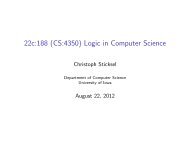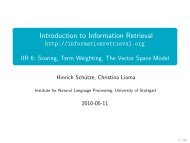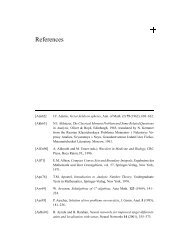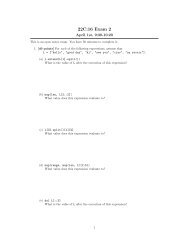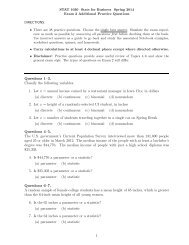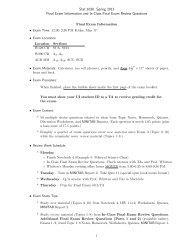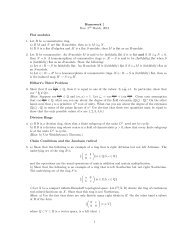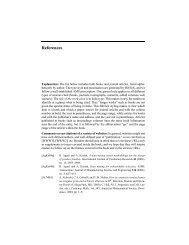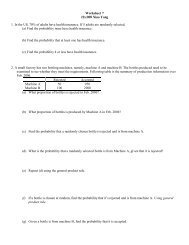A Constraint Solver and its Application to Path Feasibility Analysis.
A Constraint Solver and its Application to Path Feasibility Analysis.
A Constraint Solver and its Application to Path Feasibility Analysis.
Create successful ePaper yourself
Turn your PDF publications into a flip-book with our unique Google optimized e-Paper software.
International Journal of Software Engineering & Knowledge EngineeringVol. 11, No. 2 (2001) 139–156c○ World Scientific Publishing CompanyA CONSTRAINT SOLVER AND ITS APPLICATION TOPATH FEASIBILITY ANALYSIS ∗JIAN ZHANG <strong>and</strong> XIAOXU WANGLabora<strong>to</strong>ry of Computer Science, Institute of Software,Chinese Academy of Sciences, Beijing 100080, ChinaMany testing methods are based on program paths. A well-known problem with themis that some paths are infeasible. To decide the feasibility of paths, we may solve a se<strong>to</strong>f constraints. In this paper, we describe constraint-based <strong>to</strong>ols that can be used forthis purpose. They accept constraints expressed in a natural form, which may involvevariables of different types such as integers, Booleans, reals <strong>and</strong> fixed-size arrays. Theconstraint solver is an extension of a Boolean satisfiability checker <strong>and</strong> it makes use ofa linear programming package. The solving algorithm is described, <strong>and</strong> examples aregiven <strong>to</strong> illustrate the use of the <strong>to</strong>ols. For many paths in the testing literature, theirfeasibility can be decided in a reasonable amount of time.Keywords: <strong>Constraint</strong> solving; test data generation; infeasible paths; arrays.1. IntroductionProgram testing methods can be roughly divided in<strong>to</strong> two categories: black-box <strong>and</strong>white-box. The former is based on the functional specification, while the latter usesthe source code of the program.Many white-box testing methods can be viewed as path-oriented. We select aset of paths of the program, such that some criteria are met. A commonly usedcriterion is statement coverage, which means that all statements should be includedin the chosen set of paths. There are also other criteria such as branch coverage<strong>and</strong> path coverage.To execute each path, we need <strong>to</strong> find appropriate values for the input variables.This problem is called test data generation. If no values of the variables can causethe program <strong>to</strong> be executed along a path, we say that the path is infeasible ornon-executable. A well-known problem in program testing is that many paths areinfeasible [1, 2]. In this paper, we shall describe constraint-based <strong>to</strong>ols <strong>and</strong> theirapplication <strong>to</strong> the analysis of path feasibility.∗ A preliminary version of this paper was presented at the First Asia-Pacific Conference on QualitySoftware (APAQS 2000) [13]. This work was supported by the Natural Science Foundation of China(NSFC) under grant no. 69703014 <strong>and</strong> the National Key Basic Research Plan (NKBRSF) undergrant no. G1998030600.139
140 J. Zhang & X. WangThis paper is organized as follows. In the next section, we recall some basicconcepts of path-oriented testing <strong>and</strong> analysis. Then in Sec. 3, we briefly show how<strong>to</strong> derive a set of constraints from a path au<strong>to</strong>matically. The path is executableif these constraints are satisfiable. In Sec. 4, we describe a constraint solver <strong>and</strong><strong>its</strong> use in the analysis of path feasibility. Finally, our work is compared with otherrelated approaches, <strong>and</strong> some further research <strong>to</strong>pics are discussed.2. <strong>Path</strong>-based <strong>Analysis</strong> <strong>and</strong> TestingThe structure of a program can often be described by <strong>its</strong> control flow graph (CFG),which is a directed graph. In a CFG, a node corresponds <strong>to</strong> a simple statement orthe evaluation of a logical expression in a compound statement. The edges in thegraph denote potential flow of control between the statements. A control flow pathof the program is represented by a path in a CFG, which starts from the entrynode. It can be denoted by a sequence of nodes, or more explicitly, by a sequenceof logical expressions <strong>and</strong> simple statements.For simplicity, we do not consider subroutines or function calls within the programbody. A “program” is identified with a procedure. We shall use a C-like syntax<strong>to</strong> describe programs <strong>and</strong> algorithms. The symbol ‘=’ meansassignment,while‘==’means equality. The logical opera<strong>to</strong>rs NOT, OR, AND are denoted by ‘!’, ‘||’,‘&&’, respectively. An array a of size N consists of the elements a[0], a[1], ...,a[N-1]. Many example programs in the literature adopt the syntax of Pascal. Tobe consistent, we may add an element (i.e., a[0]) <strong>to</strong> the array, without using it inthe program. Then the body of the original example does not need <strong>to</strong> be changed.Example 1. The following procedure computes the quotient <strong>and</strong> remainder of twopositive integers.void qr(int m, int n){int q, r;/*S1*/ r = m;/*S2*/ q = 0;/*S3*/ while (r >= n) {/*S4*/ r = r-n;/*S5*/ q = q+1;}/*S6*/ printf(" %d %d\n",q,r);}Here m <strong>and</strong> n are the input integers, q is the quotient, <strong>and</strong> r is the remainder.S1, . . . , S6 are labels of the statements. The CFG is given in Fig. 1.The following are two paths of the program:<strong>Path</strong> 1: S1 S2 S3 S6.
<strong>Constraint</strong> <strong>Solver</strong> for <strong>Path</strong> <strong>Feasibility</strong> <strong>Analysis</strong> 141-EntryS1 ?S2 ?S3 ?S4 ?S5S6 Fig. 1.Control flow graph for the program qr.<strong>Path</strong> 2: S1 S2 S3 S4 S5 S3 S6.The first path may also be represented by the sequence:r = m; q = 0; !(r >= n); printf(" %d %d\n",q,r);For the sake of brevity, we assume that a path is a sequence of logical expressions<strong>and</strong> assignment statements. Output statements like printf may be omittedor replaced by the Boolean constant TRUE, because normally they do not affectthe program’s flow of control. If the path contains input statements, we can introduceauxiliary variables $inputVar i (i = 1, 2, ...). Then the statementscanf("%d",&n) can be replaced by the assignment n = $inputVar 1.The execution of a (deterministic) program depends on the initial values of theinput variables. Let us consider the above example. If the procedure is called withthe parameters m =3,n= 2, the procedure qr will be executed along <strong>Path</strong> 2. Onthe other h<strong>and</strong>, if m =2,n= 3 initially, qr will be executed along <strong>Path</strong> 1.Sometimes, programmers use assertions <strong>to</strong> increase the reliability of programs.The assertions can be checked at run-time <strong>to</strong> detect errors. Besides that, one can alsocombine test data generation techniques with assertions, so as <strong>to</strong> detect more bugs.Assertion-oriented testing is discussed in [3]. There, the assertions are translatedin<strong>to</strong> procedural code, <strong>and</strong> then an execution-based testing method is applied <strong>to</strong> thenew code.For a simple Boolean assertion, we can insert <strong>its</strong> negation in<strong>to</strong> a path <strong>and</strong> analyzethe feasibility of the new path statically. An error exists, if there are input datawhich cause the program <strong>to</strong> be executed up <strong>to</strong> the point of an assertion, <strong>and</strong> thenegated assertion is satisfied.
142 J. Zhang & X. WangFor the quotient/remainder routine in Example 1, usually we can write thepostcondition 0 ≤ r= n); (r < 0) || (r >= n);It is executable if the value of m is negative initially. But as we mentioned, theparameters m <strong>and</strong> n should be positive integers. If these preconditions are added,we obtain an infeasible path:m > 0; n > 0; r = m; q = 0; !(r >= n); (r < 0)||(r >= n);The infeasibility implies that the postcondition holds when the program executesalong <strong>Path</strong> 1.Syntactically, the negated assertions are similar <strong>to</strong> other logical expressions.In summary, for the purpose of testing or static analysis, we can select a set ofpaths from the control flow graph, <strong>and</strong> then try <strong>to</strong> find input data <strong>to</strong> execute them.Various methods for path selection have been proposed [4]. In this paper, we aremainly concerned with algorithms for finding appropriate input data such that theprogram is executed along a given path.3. Extracting <strong>Path</strong> ConditionsFor a general class of programs, many analysis problems are undecidable [5]. Forinstance, there is no algorithm that can tell us whether an arbitrary statement isreachable. Nor is there an algorithm for deciding the feasibility of program paths.However, if some restrictions are put on the programs, the problems may becomedecidable. In the present work, we assume that numeric expressions (involving integer<strong>and</strong> real variables) are linear. It is believed that, in many production softwaresystems, a large percentage of expressions <strong>and</strong> predicates are linear [6].Similar <strong>to</strong> some existing works [7, 8], we generate test data in two steps: firstlyextract a set of constraints from the given path, <strong>and</strong> then solve the constraints.Given a path, we can obtain a set of constraints called path predicates or pathconditions. The path is executable if <strong>and</strong> only if these constraints are satisfiable.Basically, there are two different ways of extracting the path conditions [7]:• Forward expansion starts from the entry node, <strong>and</strong> builds symbolic expressionsas each statement in the path is interpreted.• Backward substitution starts from the final node <strong>and</strong> proceeds <strong>to</strong> the entry node,while keeping a set of constraints on the input variables.In this paper, we focus on the backward substitution method.Given a path P ,letPC P denote the set of path conditions. As mentionedpreviously, P is a sequence of logical expressions <strong>and</strong> assignment statements. Weuse Elem P [i]<strong>to</strong>denotethei’th element of the sequence, <strong>and</strong> use Len P <strong>to</strong> denote P ’slength (i.e., the number of logical expressions <strong>and</strong> assignments in P ). The subscript
<strong>Constraint</strong> <strong>Solver</strong> for <strong>Path</strong> <strong>Feasibility</strong> <strong>Analysis</strong> 143P may be omitted when no confusion occurs. Then PC canbeobtainedinthefollowing way:for(i = Len − 1; i ≥ 0; i −−)if (Elem[i] is a logical expression)PC = PC ∪{Elem[i] };else /* Elem[i] is an assignment */substitute(PC, Elem[i]);The procedure substitute() changes the PC using an assignment. Firstly we considerthe trivial case when the left-h<strong>and</strong> side of the assignment is a simple variable x.In this case, every occurrence of x in PC is replaced by the right-h<strong>and</strong> side of theassignment.As a simple example, let us consider the following path:n > 9; n = n+1; n < 3;At first, we have the expression n < 3, which is added <strong>to</strong> the PC. Then comes theassignment n = n+1. So the constraint in the PC is changed <strong>to</strong> n+1 < 3. Finally,the expression n > 9is added, <strong>and</strong> inconsistency occurs. Thus the path is infeasible.We have implemented an au<strong>to</strong>mated <strong>to</strong>ol for path analysis <strong>and</strong> testing, calledPAT. The input consists of variable declarations followed by a path (i.e., a sequenceof assignments <strong>and</strong> logical expressions). The output is a set of constraints (i.e., thepath conditions). During the substitution, we make some simplifications <strong>to</strong> theconstraints so that they do not get <strong>to</strong>o complicated. For instance, the constrainti +5>j−1 is transformed in<strong>to</strong> the simpler one: i +6−j>0. The constraintTRUE is always omitted. As soon as the constraint FALSE is generated, we knowthat the path is infeasible, <strong>and</strong> the constraint generation process s<strong>to</strong>ps.Example 1. (Cont’d) Suppose we need input data such that the procedure qr executesalong <strong>Path</strong> 2. We may specify the path as follows:{}int m, n, q, r;r = m;q = 0;@ r >= n;r = r-n;q = q+1;@ r < n;Here we use the symbol ‘@’ <strong>to</strong> distinguish logical expressions from assignment statements.Our <strong>to</strong>ol PAT generates the following constraints:m-n >= 0; m-2n < 0;
144 J. Zhang & X. WangThe program will be executed along <strong>Path</strong> 2, if initially the positive integers m <strong>and</strong>n satisfy the above two constraints.Now we discuss the behavior of the procedure substitute() in the presenceof array assignments. Arrays are often used in most programs. Without loss ofgenerality, we consider one-dimensional arrays only. We also assume that there areno nested array expressions like a[b[i]]. During backward substitution, if the lefth<strong>and</strong>side of the assignment is an array variable a[e 0 ], we look for all sub-expressionsa[e i ](1≤i≤m) in the current PC. Here each e j (0 ≤ j ≤ m) isanumericexpression involving simple variables. From the PC, we generate 2 m new cases,each of which corresponds <strong>to</strong> a combination of equations or inequalities between e 0<strong>and</strong> e i (1 ≤ i ≤ m).For example, suppose the current constraint is a[i]+a[j] > 3, <strong>and</strong> the assignmentis a[k] =c. Then the new constraint will be the following:((k == i) && (k == j) && (2c > 3))|| ((k == i) && (k != j) && (c+a[j] > 3))|| ((k != i) && (k == j) && (a[i]+c > 3))|| ((k != i) && (k != j) && (a[i]+a[j] > 3))The above shows the most general situation. It is possible that some disjunct canbe eliminated. For example, if i =1,j=2,thenkcannot be equal <strong>to</strong> both i <strong>and</strong>j. So the first line of the new constraint is not necessary.4. <strong>Constraint</strong> SolvingAfter the path conditions are obtained, we need <strong>to</strong> decide whether they are satisfiableor not. For satisfiable conditions, we often have <strong>to</strong> find the variables’ values <strong>to</strong>satisfy them. This kind of problems have been studied by many researchers in theartificial intelligence <strong>and</strong> operations research communities.Informally speaking, a <strong>Constraint</strong> Satisfaction Problem (CSP) [9] consists of aset of variables, each of which can take values from some domain. In addition, thereare some constraints defined on the variables. Solving a CSP means finding a valuefor each variable, such that all the constraints hold.Obviously, CSP represents a very general class of problems. In practice, onetends <strong>to</strong> be more interested in specific forms of constraints.4.1. Linear programmingIn Example 1, the constraints generated by the <strong>to</strong>ol PAT are linear inequalitiesdefined on integer variables. This kind of constraints often occur in various applications.A linear programming (LP) problem [10] has a set of variables, a linear functionof the variables (called the objective function) <strong>and</strong> a set of linear inequalities or
<strong>Constraint</strong> <strong>Solver</strong> for <strong>Path</strong> <strong>Feasibility</strong> <strong>Analysis</strong> 145equations (called constraints). The goal is <strong>to</strong> find values of the variables which satisfythe constraints, such that the objective function has the maximum or minimumvalue. Usually the variables can take real numbers as their values. If the values ofsome variables are restricted <strong>to</strong> be integers, the problem is known as mixed integer(linear) programming [10].The following is a simple example of LP:Maximize 3y − xsubject <strong>to</strong> the constraintsx +5y≤8.4,2x + y ≥ 6.9.Its solution is as follows. When x =2.9, y =1.1, the objective function (3y − x)achieves the maximum value 0.4.In the normal case, the problem has a solution which satisfies the constraints<strong>and</strong> maximizes (or minimizes) the objective function. But some problems may beinfeasible or unbounded. The former means that the constraints are contradic<strong>to</strong>ry,while the latter means that the objective function does not have a finite bound.LP is tractable, <strong>and</strong> there are many efficient software packages for solvingsuch problems. Some of them are commercial products, like LINDO (availableat http://www.lindo.com). But there are also some public domain software, likelp solve. It is a mixed integer linear program solver, developed by Michel Berkelaar.It is available from ftp://ftp.ics.ele.tue.nl/pub/lp solve/.To solve the previous example, one may give the following as input <strong>to</strong> lp solve:max: 3y - x;x + 5y = 6.9;Linear programming has been used <strong>to</strong> solve path conditions <strong>and</strong> <strong>to</strong> generate testcases [11]. However, LP software cannot be used directly when logical opera<strong>to</strong>rsoccur in the constraints, e.g.,(x > 5 || y + 2z == 4) && (z
146 J. Zhang & X. Wangin conjunctive normal form (CNF), i.e., it is a conjunction of clauses, the problemis well-known as SAT. This is the first NP-hard problem [12].Many algorithms <strong>and</strong> methods have been proposed <strong>to</strong> solve the satisfiabilityproblem. Some of them are based on backtracking search, <strong>and</strong> some are based onlocal search. In this paper, we focus on backtracking algorithms. Such an algorithmworks on partial solutions. In a partial solution, some variables are assigned values.Initially, no variable has a value. The algorithm can be represented by the recursivefunction in Fig. 2. The parameters pSol <strong>and</strong> Fmla denote a partial solution <strong>and</strong>the input Boolean formula, respectively.Boolean BSat(pSol, F mla){BPropagate(pSol, F mla);if contradiction resultsreturn FALSE;if pSol assigns a truth value <strong>to</strong> every Boolean variablereturn TRUE;choose a variable x that does not have a value in pSol;if BSat(pSol ∪ {x = TRUE}, Fmla)return TRUE;if BSat(pSol ∪ {x = FALSE}, Fmla)return TRUE;return FALSE;}Fig. 2. Deciding the satisfiability of a Boolean formula.In the algorithm, BPropagate() is a procedure for simplifying the formula Fmlausing the assignments of pSol. For example, if pSol is x = TRUE, y = FALSE ,<strong>and</strong>Fmla is (x || z) && (b || y), the formula will be simplified <strong>to</strong> b. On the otherh<strong>and</strong>, if Fmla is (x && y), contradiction occurs.The execution of a backtracking algorithm may be depicted as a search tree.Each branch of the tree corresponds <strong>to</strong> a partial solution. (See Example 2 below.)4.3. BoNuSIn many cases, a constraint involves both Boolean opera<strong>to</strong>rs <strong>and</strong> numerical expressions.We have implemented a constraint solver called BoNuS [13], which is anextension of a Boolean satisfiability checker. In a constraint satisfaction problemaccepted by BoNuS, the variables can be Booleans, integers, reals or enumerated.Each constraint is a Boolean combination of primitive constraints, while a primitiveconstraint is a Boolean variable or a comparison between two numeric expressions.Example 2. Given the following input:
{}int age, salary;enum gender: female, male;bool married;bool b1 = (age > 18);bool b2 = (gender == female);bool b3 = (salary > 10000);bool b4 = (salary < 8000);imp(married, b1);imp(or(married,b2), b4);<strong>and</strong>(b2, not(b1));or(b3,married);<strong>Constraint</strong> <strong>Solver</strong> for <strong>Path</strong> <strong>Feasibility</strong> <strong>Analysis</strong> 147BoNuS can decide au<strong>to</strong>matically that the problem has no solution. The problem hastwo integer variables <strong>and</strong> one enumerated variable. In addition, there are 5 Booleanvariables, 4 of which st<strong>and</strong> for numeric constraints. There are 4 Boolean formulas<strong>to</strong> be satisfied. The symbol imp st<strong>and</strong>s for implication. So the second formula says,if a person is married or is female, the salary is less than 8000.BoNuS is written using the parsing <strong>to</strong>ol Yacc <strong>and</strong> the LP library lp solve(mentioned previously). It can be regarded as an extension of a Boolean satisfiabilitychecker. The modifications are mainly the following:(I) Prior <strong>to</strong> the SearchFor an enumerated variable v that can take values from the set {e 1 ,e 2 ,...,e n },we introduce n new Boolean variables $ve 1 ,$ve 2 ,...,$ve n . The condition “v = e i ”is replaced by $ve i . To ensure soundness, we need <strong>to</strong> add two formulas indicatingthat the values are all inclusive <strong>and</strong> mutually exclusive:$ve 1 ∨ $ve 2 ∨ ...∨$ve n ,LT E1($ve 1 , $ve 2 ,...,$ve n ) .Here LT E1 is a Boolean opera<strong>to</strong>r which means, among the n arguments, at mos<strong>to</strong>ne is true.A primitive constraint can be an inequality or an equation. BoNuS has a preprocessingstep which transforms equations in<strong>to</strong> inequalities. This is done in thefollowing way, which is straightforward. Suppose that there is a Boolean variable b ithat st<strong>and</strong>s for the primitive constraint Exp 1 = Exp 2 . Then we introduce two newBoolean variables:b i1 : Exp 1 ≤ Exp 2 , b i2 : Exp 1 ≥ Exp 2<strong>and</strong> replace b i by <strong>and</strong>(b i1 ,b i2 ). Moreover, we have <strong>to</strong> add the condition or(b i1 ,b i2 )<strong>to</strong> the Boolean formula. Otherwise, we might get a solution in which b i1 <strong>and</strong> b i2 areboth false. Disequations like Exp 1 ≠ Exp 2 are also transformed in a similar way.
148 J. Zhang & X. Wang(II) During the SearchThe search algorithm of BoNuS is essentially the same as the procedure BSat()(Fig. 2), except for the constraint propagation step. The procedure BPropagate()only uses inference rules from the Boolean logic (or the propositional logic). However,in BoNuS, numeric expressions have <strong>to</strong> be considered.In the input of BoNuS, if a Boolean variable nb st<strong>and</strong>s for a numeric constraint,we denote that primitive constraint by prCons(nb). During the search process,when we got a partial solution pSol which assigns truth values <strong>to</strong> some Booleanvariables, we obtain a set of inequalities (denoted by Ψ) as follows.Ψ is empty initially;for each Boolean variable b which has a value in pSol {if b is TRUE, add prCons(b) <strong>to</strong>Ψ;otherwise, add the negation of prCons(b) <strong>to</strong>Ψ;}Then we use linear programming <strong>to</strong> decide the feasibility of Ψ. If the inequalitiesare found <strong>to</strong> be infeasible, the algorithm backtracks.A Boolean variable may be assigned FALSE in a partial solution, yet we cannotgive the constraint exp 1 ≠ exp 2 <strong>to</strong> a LP package. That is why we have <strong>to</strong> transformequations in<strong>to</strong> inequalities before the backtracking search procedure is started.Otherwise, suppose there is a Boolean variable b, <strong>and</strong>prCons(b) isx=y+3. Ifit happens that, during the search, b becomes false in the partial solution. Then Ψcontains the constraint x ≠ y + 3, <strong>and</strong> it is impossible <strong>to</strong> check the feasibility of Ψby linear programming.Example 2. (Cont’d)The search tree is like the following:ϕrb4 = ,@ ,F T @@, r⊗b3= F,@ T , @@,⊗ ⊗There are three branches:1. In the first branch, b4 is false. From this assignment <strong>and</strong> the second Booleanformula imp(or(married,b2),b4), we know that both married <strong>and</strong> b2 are false.Thus the third Boolean formula <strong>and</strong>(b2,not(b1)) cannot be satisfied.2. In this partial solution, b4 is true, but b3 is false. Again, contradiction occurs asa result of Boolean reasoning. From the last Boolean formula or(b3,married),we know that married must be true. Then the first formula imp(married,b1)
<strong>Constraint</strong> <strong>Solver</strong> for <strong>Path</strong> <strong>Feasibility</strong> <strong>Analysis</strong> 149forces b1 <strong>to</strong> be true. And the third Boolean formula <strong>and</strong>(b2,not(b1)) cannotbe satisfied.3. Both b3 <strong>and</strong> b4 are true. Contradiction occurs, because b3 st<strong>and</strong>s for (salary> 10000), b4 st<strong>and</strong>s for (salary < 8000), <strong>and</strong> it is impossible for salary <strong>to</strong>be less than 8000 <strong>and</strong> greater than 10000. This kind of inconsistency is detectedby a linear programming package.Non-linear constraints may also be given <strong>to</strong> BoNuS. But we do not expect thatall such problems can be solved. For details about the non-linear case, see [13].4.4. ArraysTo use a <strong>to</strong>ol like BoNuS, we need <strong>to</strong> transform arrays in the constraints in<strong>to</strong>simple variables. There are two methods for doing this. The first way is <strong>to</strong> treatsyntactically different array expressions as different variables. For example, theconstraint a[i +1]>k−2 is regarded as a i plus 1 >k−2, where a i plus 1is a new variable. It is not difficult <strong>to</strong> see that, when the new constraints areunsatisfiable, so are the original constraints. But the converse is not true.A more accurate way is as follows. For an array a of size l, we introduce l simplevariables: $a 0 , $a 1 ,...,$a l−1 . An array expression a[exp] will be replaced by sucha simple variable, depending on the value of exp. Suppose l = 3, then a constraintlike a[x + y] > 5 will be translated <strong>to</strong> the following:((x+y == 0) && $a0 > 5)) ||((x+y == 1) && $a1 > 5)) ||((x+y == 2) && $a2 > 5))This method is more expensive, because it introduces more variables <strong>and</strong> generatesmore constraints.Example 3. In [14], an execution trace of a program is given. But there is a typoin the code, <strong>and</strong> the path is actually not executable. To see this, we may give thefollowing as input <strong>to</strong> PAT.int max, min, sum, i, k, n, a[6];{ max = a[1];min = a[1];sum = a[1];i = k+1;@ i a[i];sum = sum + a[i];i = i+k;
<strong>Constraint</strong> <strong>Solver</strong> for <strong>Path</strong> <strong>Feasibility</strong> <strong>Analysis</strong> 151{}int fa, fb, i, t;int a[4], b[4];i = 1;fa = 0;fb = 0;while (i
<strong>Constraint</strong> <strong>Solver</strong> for <strong>Path</strong> <strong>Feasibility</strong> <strong>Analysis</strong> 153These rules only provide a partial solution <strong>to</strong> the feasibility problem, even underthe restriction that all numeric expressions are linear.In contrast <strong>to</strong> the incomplete methods, <strong>Constraint</strong> Logic Programming (CLP)systems can find a solution if the constraints are satisfiable, <strong>and</strong> they can also detectthe unsatisfiability of constraints. (For more information about CLP, see the survey[21].) Examples of CLP systems include Prolog III, CHIP <strong>and</strong> CLP(R). Someof them are quite expressive <strong>and</strong> efficient. But it is not easy <strong>to</strong> use them directlyfor path feasibility analysis. Most of them are based on Horn clauses. Yet the constraintsgenerated from program paths can be non-Horn or even non-clausal. (An exampleof such formulas, which is quite complicated, is given at the end of [22].) Morerecent constraint programming systems like ILOG <strong>Solver</strong> (http://www.ilog.fr)are not restricted <strong>to</strong> the Horn logic.Many CLP systems support only a few data types (such as finite domain integers<strong>and</strong> real numbers). For example, the test data generation <strong>to</strong>ol INKA [16] generatesconstraints <strong>and</strong> then solves them using CLP(FD). The latter is a finite-domainconstraint solver <strong>and</strong> it is an extension of Prolog. All variables are integers that cantake values from some finite domains, e.g., x ∈ [1, 9]. The system CLP(R) [23] c<strong>and</strong>eal with real numbers, but it has difficulty with linear inequalities. Eliminatingvariables from the inequalities is very expensive.In addition <strong>to</strong> the above methods, one may also use general-purpose theoremprovers or checkers. For example, the resolution-style theorem prover KITP has beensuggested as the main <strong>to</strong>ol <strong>to</strong> determine the feasibility of test specifications [24]. Theuser tries <strong>to</strong> prove a conjecture using st<strong>and</strong>ard axioms of arithmetic <strong>and</strong> conditionalrewrite rules. This approach is very general, but it can hardly be au<strong>to</strong>mated.In most cases, when the numeric expressions are linear, a better alternativeis <strong>to</strong> use decision procedures for Presburger arithmetic <strong>to</strong> detect non-executablepaths. Presburger formulas are first-order logical formulas defined on the integerdomain, with the restriction that the arithmetic operations on integer variables canonly be addition <strong>and</strong> subtraction. Non-linear numeric expressions are not allowed.But the formulas may have universal <strong>and</strong> existential quantifiers (∀, ∃). Presburgerarithmetic is decidable, but the decision procedures suffer from very high worstcasecomplexity [25]. For the purpose of feasibility analysis, we think that it is<strong>to</strong>o expressive. If the constraints are <strong>to</strong> be represented as logical formulas, onlyexistential quantifiers are needed. The path exploration <strong>to</strong>ol PET [26] uses thePresburger arithmetic decision procedure built in the prover HOL. In the inputlanguage of PET, the variables can only be integers.Besides path-oriented testing, constraint solving techniques can be applied inother ways <strong>to</strong> increase the reliability of software. For instance, in specificationbasedtesting, we need <strong>to</strong> decide the satisfiability of constraints [27]. In [13], itis shown that <strong>to</strong>ols like BoNuS can be used <strong>to</strong> check potential inconsistency <strong>and</strong>incompleteness in state-based requirement specifications.
154 J. Zhang & X. Wang6. Concluding RemarksA major difficulty with path-oriented testing methods is that many paths turn out<strong>to</strong> be non-executable or infeasible. This also occurs frequently in the assertion-basedanalysis approach, where a postcondition is negated. (Unless the program containsmany bugs, the negated postcondition is usually not satisfiable.)To determine the feasibility of program paths, we may generate a set of constraints<strong>and</strong> then decide their satisfiability. This can be done by h<strong>and</strong> or with thehelp of various <strong>to</strong>ols (such as theorem provers, decision procedures <strong>and</strong> constraintsolvers). We believe that the constraint solving approach is better in terms of efficiency<strong>and</strong> degree of au<strong>to</strong>mation. However, many existing constraint solvers are notso easy <strong>to</strong> use for the purpose of program testing. Our experiences indicate thatthe constraints are generally not <strong>to</strong>o difficult <strong>to</strong> solve, but they may be complicatedsyntactically. There can be variables of different types <strong>and</strong> many Boolean opera<strong>to</strong>rs.In this paper, we describe constraint-based <strong>to</strong>ols for determining the feasibilityof paths. The <strong>to</strong>ol PAT extracts path conditions, while BoNuS is used <strong>to</strong> solvethem. They can be combined <strong>to</strong> generate test data <strong>and</strong> <strong>to</strong> detect infeasible paths.The <strong>to</strong>ols are highly au<strong>to</strong>matic, <strong>and</strong> they allow the user <strong>to</strong> specify constraints <strong>and</strong>paths in a very natural way. Common data types such as integers, Booleans, <strong>and</strong>arrays are accepted. PAT can also be used as a front-end <strong>to</strong> constraint solvers likeBoNuS, since a “path” can contain logical expressions only (without assignmentstatements). The <strong>to</strong>ols may also be combined with other path selection methods<strong>and</strong> <strong>to</strong>ols (e.g., that of [4]), <strong>to</strong> generate executable test cases.One problem with our approach is that LP packages like lp solve suffer fromrounding errors when dealing with real numbers. This is not <strong>to</strong>o serious, since inmany cases, there is not much numerical computation, <strong>and</strong> the constraints are eitherunsatisfiable or easily satisfiable. The main drawback of our approach is thecomplexity of the underlying algorithms. We do not expect that it works on largeprograms. However, bad theoretical results do not necessarily imply that a particularproblem instance cannot be solved quickly. Moreover, the performance ofcomputer hardware has been improved rapidly. In the future, we will make improvements<strong>to</strong> the search algorithm <strong>and</strong> find better ways <strong>to</strong> deal with arrays. We alsoplan <strong>to</strong> study other data types such as pointers <strong>and</strong> character strings. We believethat our <strong>to</strong>ols are useful in the evaluation of algorithms <strong>and</strong> in the unit testingphase of software development.AcknowledgementsThe authors would like <strong>to</strong> thank the anonymous reviewers for careful reading of anearlier draft <strong>and</strong> for their suggestions.References1. D. Hedley <strong>and</strong> M. A. Hennell, “The causes <strong>and</strong> effects of infeasible paths in computerprograms”, Proc. 8th Int. Conf. on Software Engineering (1985), pp. 259–266.
<strong>Constraint</strong> <strong>Solver</strong> for <strong>Path</strong> <strong>Feasibility</strong> <strong>Analysis</strong> 1552. E. J. Weyuker, “An empirical study of the complexity of data flow testing”, Proc.2nd Workshop on Software Testing, Verification <strong>and</strong> <strong>Analysis</strong>, Banff, Alberta, Canada(1988), pp. 188–195.3. B. Korel <strong>and</strong> A. M. Al-Yami, “Assertion-oriented au<strong>to</strong>mated test data generation”,Proc. 18th Int. Conf. on Software Engineering (1996), pp. 71–80.4. A. Ber<strong>to</strong>lino <strong>and</strong> M. Marré, “Au<strong>to</strong>matic generation of path covers based on the controlflow analysis of computer programs”, IEEE Trans. Softw. Eng. SE-20 (1994) 885–899.5. E. Weyuker, “Translatability <strong>and</strong> decidability questions for restricted classes of programschemas”, SIAM J. on Computing 8 (1979) 587–598.6. L. J. White <strong>and</strong> E. I. Cohen, “A domain strategy for computer program testing”,IEEE Trans. Softw. Eng. SE-6 (1980) 247–257.7. L. A. Clarke <strong>and</strong> D. J. Richardson, “Symbolic evaluation methods — Implementations<strong>and</strong> applications”, in Computer Program Testing, eds. B. Ch<strong>and</strong>rasekaran <strong>and</strong>S. Radicchi (North-Holl<strong>and</strong>, Amsterdam, 1981), pp. 65–102.8. R. A. DeMillo <strong>and</strong> A. J. Offutt, “<strong>Constraint</strong>-based au<strong>to</strong>matic test data generation”,IEEE Trans. Softw. Eng. SE-17 (1991) 900–910.9. A. K. Mackworth, “<strong>Constraint</strong> satisfaction,” in Encyclopedia of Artificial Intelligence,(ed.) S. C. Shapiro, Vol. 1 (John Wiley, New York, 1990), pp. 205–211.10. P. R. Thie, An Introduction <strong>to</strong> Linear Programming <strong>and</strong> Game Theory (John Wiley,New York, 1979).11. P. D. Coward, “Symbolic execution <strong>and</strong> testing”, Information <strong>and</strong> SoftwareTechnology 33 (1991) 53–64.12. M. R. Garey <strong>and</strong> D. S. Johnson, Computers <strong>and</strong> Intractability: A Guide <strong>to</strong> the Theoryof NP-Completeness (W. H. Freeman, San Francisco, 1979).13. J. Zhang, “Specification analysis <strong>and</strong> test data generation by solving Boolean combinationsof numeric constraints”, Proc. First Asia-Pacific Conference on QualitySoftware, Hong Kong (Oct. 2000), pp. 267–274.14. B. Korel <strong>and</strong> S. Yalamanchili, “Forward computation of dynamic program slices”,Proc. Int’l Symp. on Software Testing <strong>and</strong> <strong>Analysis</strong> (ISSTA’94 ), Seattle, Washing<strong>to</strong>n,USA (1994), pp. 66–79.15. R. Ferguson <strong>and</strong> B. Korel, “The chaining approach for software test data generation”,ACM Trans. on Softw. Eng. <strong>and</strong> Methodology 5 (1996) 63–86.16. A. Gotlieb, B. Botella <strong>and</strong> M. Rueher, “Au<strong>to</strong>matic test data generation using constraintsolving techniques”, Proc. Int’l Symp. on Software Testing <strong>and</strong> <strong>Analysis</strong>(ISSTA’98 ), Clearwater Beach, Florida, USA (1998), pp. 53–62.17. N. Tracey, J. Clark, <strong>and</strong> K. M<strong>and</strong>er, “Au<strong>to</strong>mated program flaw finding using simulatedannealing”, Proc. Int’l Symp. on Software Testing <strong>and</strong> <strong>Analysis</strong> (1998), pp. 73–81.18. B. Korel <strong>and</strong> J. Laski, “STAD — A system for testing <strong>and</strong> debugging: User perspective”,Proc. 2nd Workshop on Software Testing, Verification <strong>and</strong> <strong>Analysis</strong>, Banff,Alberta, Canada (1988), pp. 13–20.19. R. P. Pargas, M. J. Harrold <strong>and</strong> R. R. Peck, “Test-data generation using geneticalgorithms”, Software Testing, Verification <strong>and</strong> Reliability (1999).20. A. J. Offutt <strong>and</strong> J. Pan, “Au<strong>to</strong>matically detecting equivalent mutants <strong>and</strong> infeasiblepaths,” Software Testing, Verification <strong>and</strong> Reliability 7 (1997) 165–192.21. J. Jaffar <strong>and</strong> M. J. Maher, “<strong>Constraint</strong> logic programming: A survey,” J. of LogicProgramming 19/20 (1994) 503–581.22. A. Goldberg, T. C. Wang <strong>and</strong> D. Zimmerman, “<strong>Application</strong>s of feasible path analysis<strong>to</strong> program testing”, Proc. Int’l Symp. on Softw. Testing <strong>and</strong> <strong>Analysis</strong> (ISSTA’94 ),Seattle, Washing<strong>to</strong>n, USA (1994), pp. 80–94.23. N. C. Heintze, J. Jaffar, S. Michaylov, P. J. Stuckey <strong>and</strong> R. H. C. Yap, “The CLP(R)
156 J. Zhang & X. Wangprogrammer’s manual”, Version 1.2, Sept. 1992.24. R. Jasper, M. Brennan, K. Williamson, B. Currier <strong>and</strong> D. Zimmerman, “Test datageneration <strong>and</strong> feasible path analysis”, Proc. Int’l Symp. on Software Testing <strong>and</strong><strong>Analysis</strong> (ISSTA’94 ) Seattle, Washing<strong>to</strong>n, USA (1994) pp. 95–107.25. D. Oppen, A 2 22pn upper bound on the complexity of Presburger arithmetic, J. ofComputer <strong>and</strong> System Sciences 16 (1978) 323–332.26. E. L. Gunter <strong>and</strong> D. Peled, <strong>Path</strong> exploration <strong>to</strong>ol, Proc. of the 5th Int’l Conf. onTools <strong>and</strong> Algorithms for the Construction <strong>and</strong> <strong>Analysis</strong> of Systems (TACAS’99 ),Amsterdam, The Netherl<strong>and</strong>s (1999), Lecture Notes in Computer Science, Vol. 1579,pp. 405–419.27. A. J. Offutt <strong>and</strong> S. Liu, “Generating test data from SOFL specifications”, J. of Systems<strong>and</strong> Software 49 (1999) 49–62.



